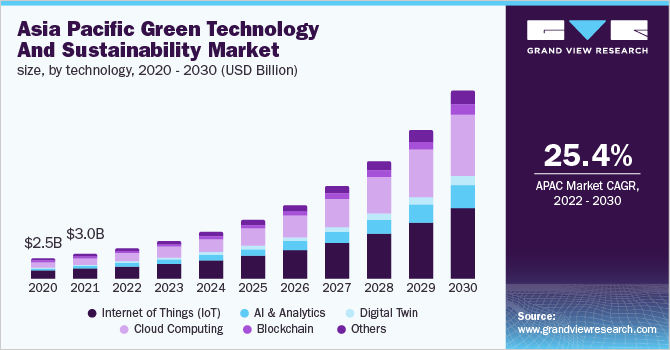
Report Overview
The global green technology and sustainability market size was valued at USD 13.28 billion in 2021 and is expected to expand at a compound annual growth rate (CAGR) of 22.4% from 2022 to 2030. The industry is expected to grow as environmental awareness and concern about global warming rise among organizations and individuals. Green technology uses various forms of sustainable energy to safeguard the environment. Solar panels, LED lighting, wind energy, vertical farming, electric vehicles, and composting are a few examples of green technologies.
Asia Pacific green technology and sustainability market size, by technology, 2020 – 2030 (USD Billion)
Furthermore, several countries worldwide employ green technologies to manage and recycle waste from industry and households. Green technology also aids enterprises in reducing emissions, conserving water, reducing waste, and using less energy than traditional technology. These advantages of sustainable technology have a substantial impact on its global adoption.
Nations worldwide are focusing on technological improvements to deliver more sustainable solutions. With the ongoing conflict in Ukraine, the EU aims to speed up its green transition to lessen its reliance on Russian fossil resources. For instance, the European Commission is expected to propose a new legislative package to increase renewable energy use and energy savings, albeit it will continue to rely on gas imported from other nations. It will also shorten the license processing time for renewable energy projects, which will not exceed one year.
Solar and wind farms bear a high capital cost of construction and installation. On the contrary, solar and wind farms are inexpensive because their fuel is free and maintenance is minimal; thus, most of the money is spent on developing technology-based products or solutions. Carbon footprint management, air quality monitoring, and air and water pollution monitoring are just a few applications where cutting-edge technologies like Internet of Things (IoT) sensors and analytics need significant maintenance costs.
For example, when it comes to air quality monitoring software, which is used to analyze and test air quality parameters, detecting chemical and biological components from the air necessitates advanced cutting technologies, such as gas sensors and PCR-based biosensors, which are both expensive.
The World Health Organization declared COVID-19 a pandemic in March 2020, putting numerous countries into lockdown. The COVID-19 pandemic significantly impacted the green technology and sustainability business. Over the forecasted timeframe, altering consumer choices and behavior due to the changing worldwide pandemic environment will have a significant impact on the growth of the market.
Reduced carbon emissions, improved solar energy output, increased rainfall received, and growing use cases of various technologies throughout various industrial verticals during the pandemic may result in expanded green technology use. Furthermore, a greater emphasis on environmental protection across many businesses will benefit the green technology and sustainability market.
Summary: relevance to Moldova
According to the IEA, Moldova has already reached its overall share of energy from renewable sources 2020 target, taking into account the binding target of 17% of energy from renewable sources in gross final energy consumption by 2020, set by the EnC-MC decision in 2012, and 20% of the voluntary target set in the National Energy Strategy 2030. However, Moldova ranks the lowest among European countries in terms of investment in environmental protection, with both the government and businesses spending too little for these purposes compared with most European countries. Therefore, there is a need for more investment in green technology in Moldova to achieve a sustainable future.